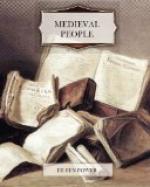However, it was not in material things, that the contemporaries found, or should have found the sharpest conflict between Rome and the barbarian prospects before it. Above all Roman civilization was a civilization of the mind. It had behind it a long tradition of thought and of intellectual achievement, the legacy of Greece, to which it had in turn made its own contribution. The Roman world was a world of schools and universities, writers, and builders. The barbarian world was a world in which mind was in its infancy and its infancy was long. The battle sagas of the race, which have all but disappeared or have survived only as legends worked up in a later age; the few rude laws which were needed to regulate personal relationships, this was hardly civilization in the Roman sense. King Chilperic, trying to make verses in the style of Sedulius, though he could not distinguish between a long foot and a short and they all hobbled; Charlemagne himself, going to bed with his slate under his pillow in order to practice in the watches of the night that art of writing which he never mastered; what have they in common with Julius Caesar and Marcus Aurelius and that great Julian called the Apostate? They sum up in their very persons the whole wide gulf that yawned between Germany and Rome.
Rome and the barbarians were thus not only protagonists but two different attitudes to life, civilization and barbarism. We cannot here discuss in detail the question as to why, in the clash between the two, it was civilization which perished and barbarism which prevailed. But it is important to remember that while the Empire tried to defend its frontiers against the barbarian hosts, it gradually opened them to barbarian settlers.
This peaceful infiltration of barbarians which altered the whole character of the society which it invaded would have been impossible, of course, if that society had not been stricken by disease. The disease is plain enough to see by the third century. It shows itself in those internecine civil wars in which civilization rends itself, province against province and army against army. It shows itself in the great inflationary crisis from about 268 and in the taxation which gradually crushed out the smaller bourgeoisie while the fortunes of the rich escaped its net. It shows itself in the gradual sinking back of an economy based upon free exchange into more and more primitive conditions when every province seeks to be self-sufficient and barter takes the place of trade. It shows itself in the decline of farming and in the workless city population kept quiet by their dole of bread and their circuses, whose life contrasted so dramatically, so terribly with that of the haughty senatorial families and the great landowners in their palatial villas and town houses. It shows itself in the rise of mystical faiths on the ruins of philosophy, and of superstition (more especially astrology) on the ruins of reason. One religion




